1994 CHEVROLET S10 load capacity
[x] Cancel search: load capacityPage 112 of 340
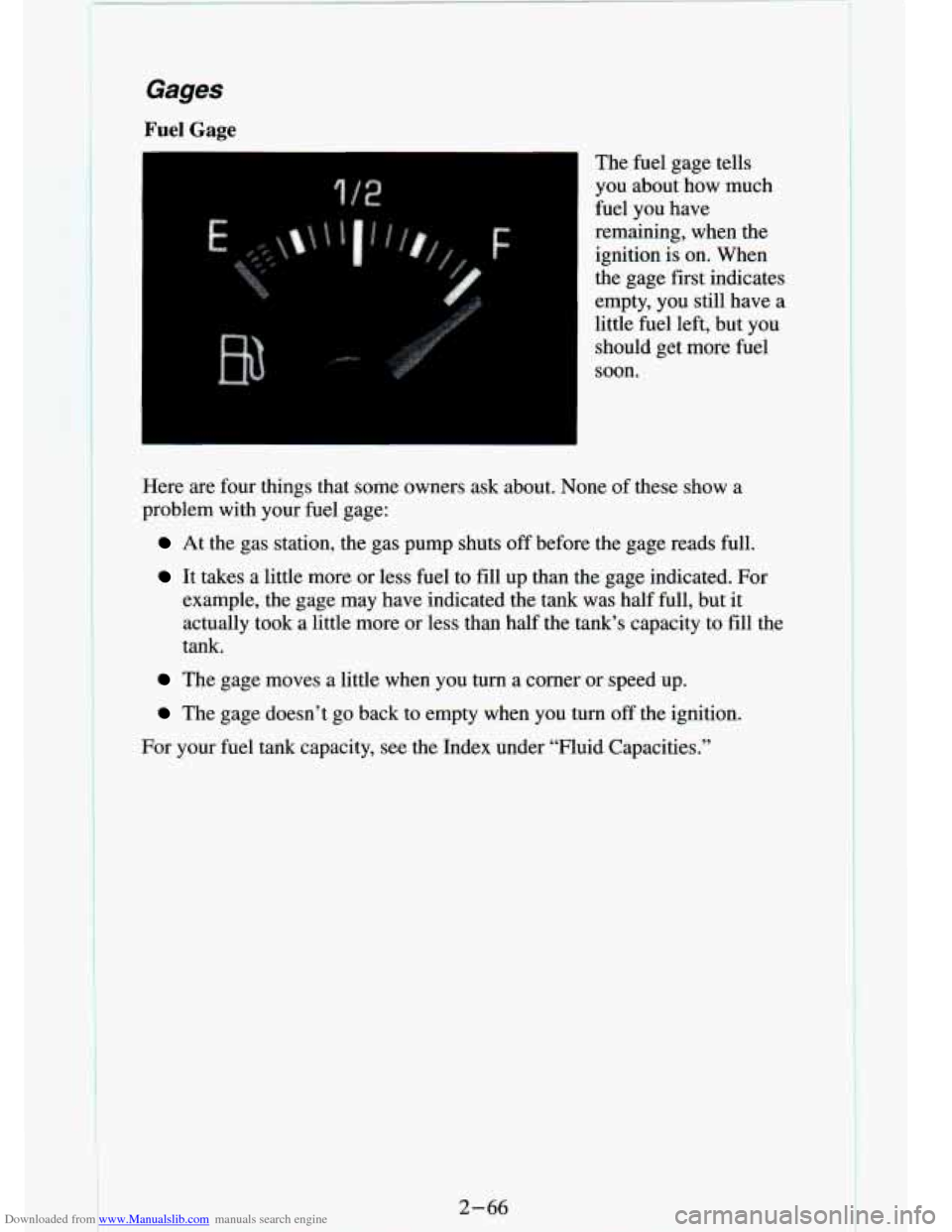
Downloaded from www.Manualslib.com manuals search engine Gages
Fuel Gage The fuel gage tells
you about how much
fuel you have
remaining, when the
ignition is on. When
the gage first indicates
empty, you still have a
little fuel left, but you should get more fuel
soon.
Here are four things that some owners ask about. None of these show a
problem with your fuel gage:
At the gas station, the gas pump shuts off before the gage reads full.
It takes a little more or less fuel to fill up than the gage indicated. For
example, the gage may have indicated the tank was half full, but
it
actually took a little more or less than half the tank’s c\
apacity to fill the
tank.
The gage moves a little when you turn a corner or speed up.
The gage doesn’t go back to empty when you turn off the ignition.
For your fuel tank capacity, see the Index under “Fluid Capacities.”
2-66
Page 175 of 340
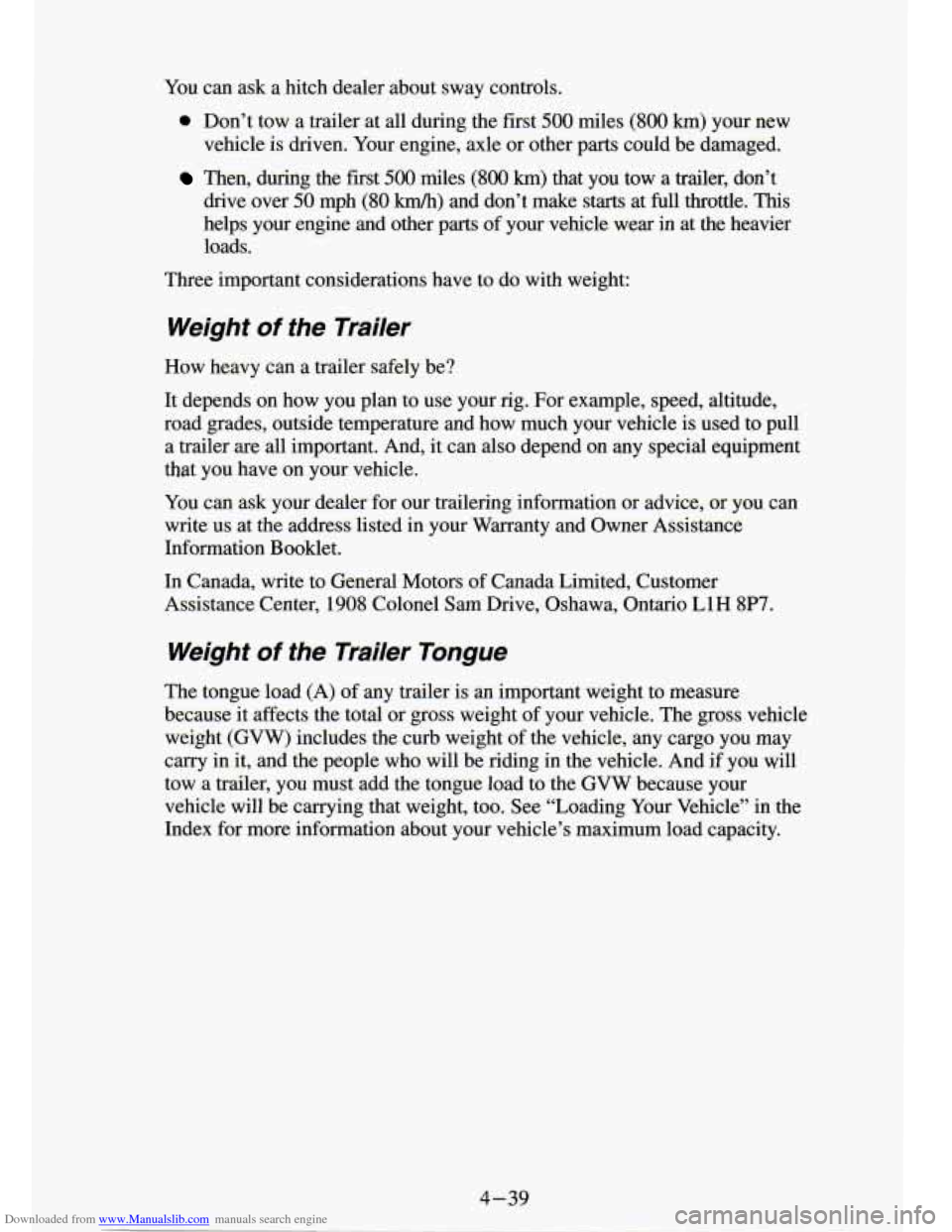
Downloaded from www.Manualslib.com manuals search engine You can ask a hitch dealer about sway controls.
0 Don’t tow a trailer at aU during the first 500 miles (800 km) your new
vehicle is driven. Your engine, axle or other
parts could be damaged.
Then, during the fist 500 miles (800 km) that you tow a trailer, don’t
drive over
50 mph (80 kmk) and don’t make starts at full throttle. This
helps your engine and other
parts of your vehicle wear in at the heavier
loads.
Three important considerations have to da with weight:
Weight of the Trailer
How heavy can a .trailer safely be?
It depends on how you plan to use your rig. For example, speed, altitude,
road grades, outside temperature and how much your vehicle is used to pull
a trailer are all important. And, it can also depend on any special equipment
that you have
on your vehicle.
You can ask
your dealer for our trailering information or advice, or you can
write us at the address listed
in your Warranty and Owner Assistance
Information Booklet.
In Canada, write to General Motors of Canada Limited, Customer
Assistance Center,
1908 Colonel Sam Drive, Oshawa, Ontario L1H 8P7.
Weight of the Trailer Tongue
The tongue load (A) of any trailer is an important weight to measure
because it affects the total or gross weight
of your vehicle. The gross vehicle
weight (GVW) includes the curb weight of the vehicle, any cargo you may
carry in it, and the people who will be riding in the vehicle. And
if you will
tow a trailer, you must add the tongue load to the GVW because your\
vehicle will be carrying that weight,
too. See “Loading Your Vehicle” in the
Index for more infomation about your vehicle’s maximum load capacity.
4-39
Page 227 of 340
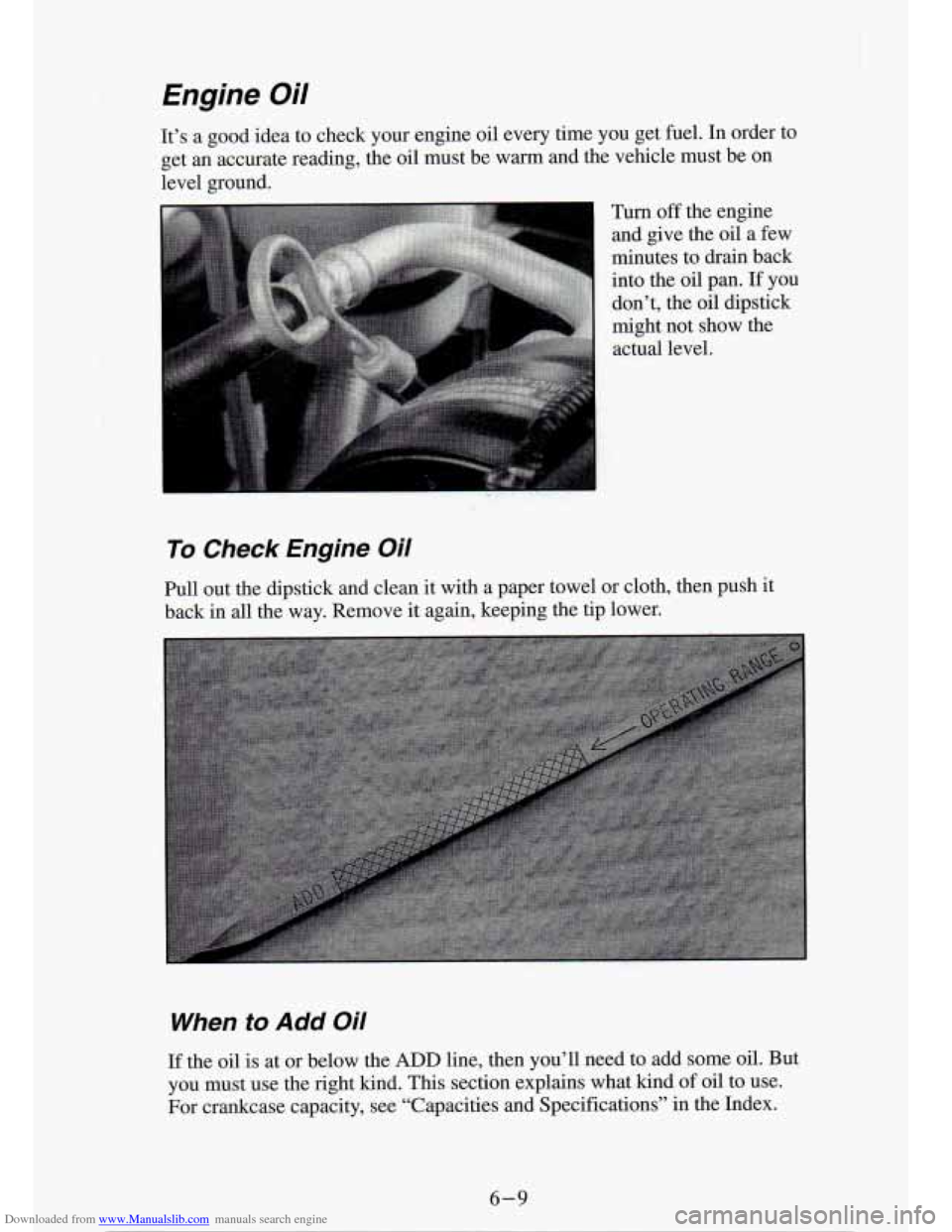
Downloaded from www.Manualslib.com manuals search engine Engine Oil
It’s a good idea to check your engine oil every time you get fuel. In order to
get an accurate reading, the oil must be warm
and the vehicle must be on
level ground.
Turn
off the engine
and give the oil a
few
rninutes to drain back
into the
oil pan. If you
don’t, the oil dipstick
might not show the
actual level.
To Check Engine Oil
Pull out the dipstick and clean it with a paper towel or cloth, then push it
back in all the way. Remove it again, keeping the tip lower.
When to Add Oil
If the oil is at or below the ADD line, then you’ll need to add some oil. But
you must use the right kind.
This section explains what kind of oil to use.
For crankcase capacity, see “Capacities and Specifications” in the Index.
6-9
Page 263 of 340

Downloaded from www.Manualslib.com manuals search engine Engine Control Module System
This system has an oxygen (02) sensor that helps keep your engine’s
air-fuel mixture at a proper level. Use only unleaded fuel in your vehicle.
If
you use leaded fuel, you could damage your oxygen (02) sensor and affect
your vehicle’s emissions.
Loading Your Vehicle
The CertificatiodTire label is found on the driver’s door lock pillar. The
label shows the size of your original tires and the inflation pressures needed
to obtain the
gross weight capacity of your vehicle. This is called the
GVWR (Gross Vehicle Weight Rating). The GVWR includes the weight of
the vehicle,
all occupants, fuel and cargo.
The CertificatiodTire label
also tells you the maximum weights for the
front and rear axles, called Gross Axle Weight Rating
(GAWR). To find out
the actual
loads on your front and rear axles, you need to go to a weigh
station and weigh
your vehicle. Your dealer can help you with this. Be sure
to spread out your load equally
on both sides of the centerline.
Never exceed the GVWR for your vehicle, or the Gross Axle Weight Rating
(GAWR) for either the front or rear axle.
And, if you do have a heavy load, you should spread it out.
6-45
Page 265 of 340
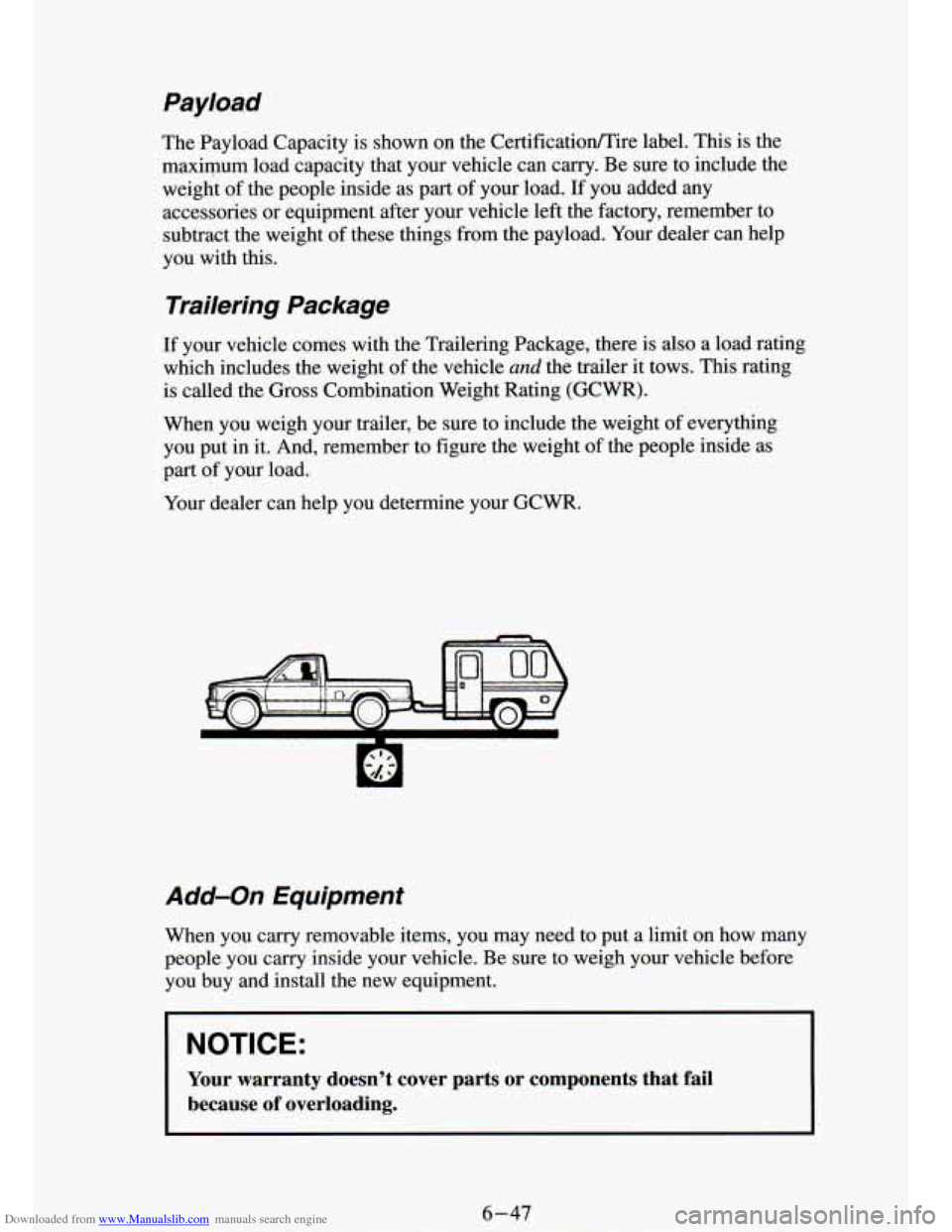
Downloaded from www.Manualslib.com manuals search engine Payload
The iyload Capacity is shown on the Certificatioflire label. This is the
maximum load capacity that your vehicle can carry. Be sure to \
include the
weight of the people inside as part of your load.
If you added any
accessories or equipment after your vehicle left the factory, remember to
subtract the weight of these things from the payload. Your dealer can help
you with this.
Trailering Package
If your vehicle comes with the Trailenng Package, mere is also a load rating
which includes the weight of the vehicle
and the trailer it tows. This rating
is called the Gross Combination Weight Rating (GCWR).
When you weigh your trailer, be sure to include the weight of everything
you put
in it. And, remember to figure the weight of the people inside as
part of your load.
Your dealer can help you determine your
GCWR.
Add-on Equipment
When you carry removable items, you may need to put a limit \
on how many
people you carry inside your vehicle. Be sure to weigh your v\
ehicle before you buy and install the new equipment.
NOTICE:
Your warranty doesn’t cover parrs or components that fail
because of overloading.
Page 271 of 340
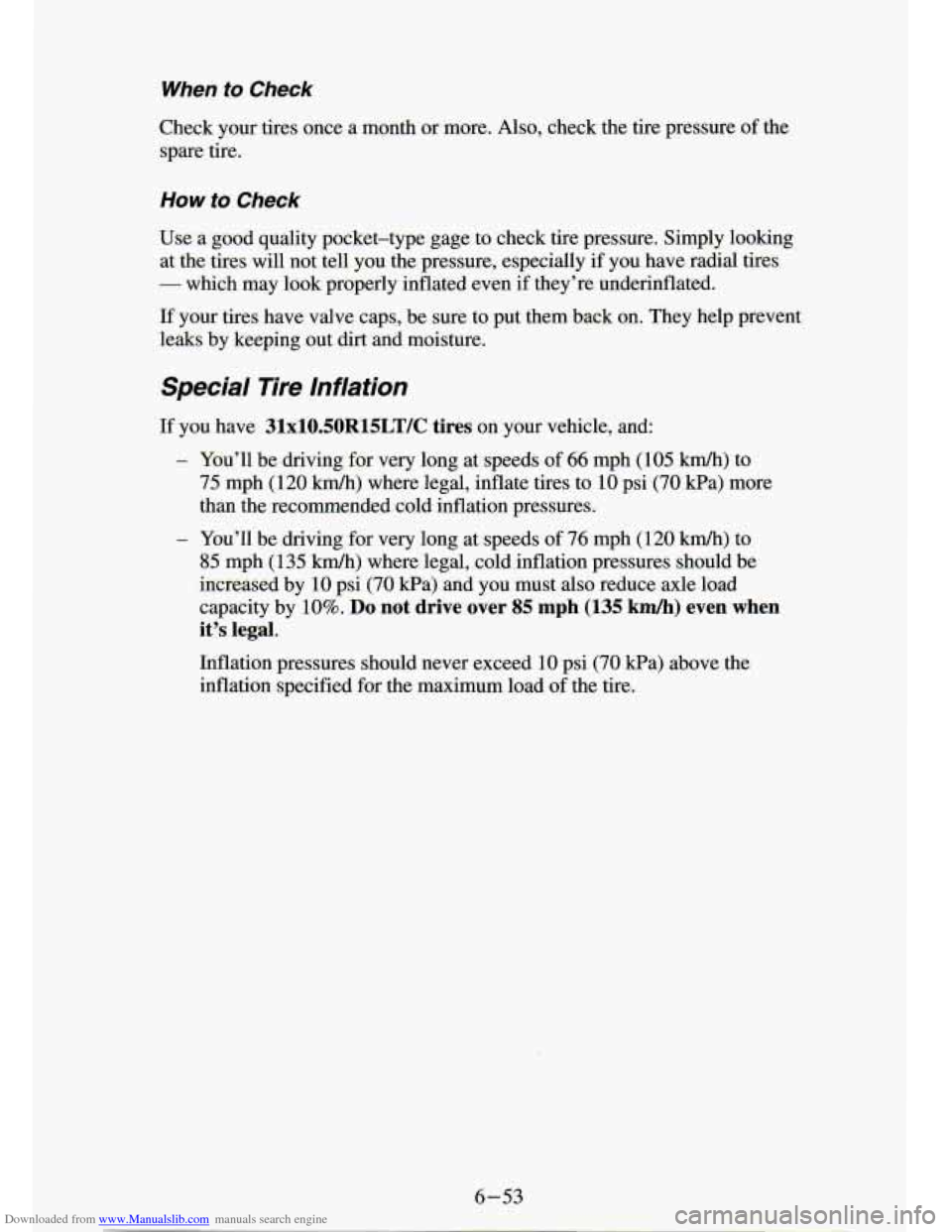
Downloaded from www.Manualslib.com manuals search engine When to Check
Check your ..’ :s once a month or more. Also, check the tire pressure of the
spare tire.
How to Check
Use a good quality pocket-type gage to check tire pressure. Si\
mply looking at the tires will
not tell you the pressure, especially if you have radial tires
- which may look properly inflated even if they’re underinflated.
If your tires have valve caps, be sure to put them back on. The\
y help prevent
leaks by keeping out
dirt and moisture.
Special Tire Inflation
If you have 31xlOSOR15LT/C tires on your vehicle, and:
- You’ll be driving for very long at speeds of 66 mph (105 km/h) to
75 mph (120 km/h) where legal, inflate tires to 10 psi (70 Wa) more
than the recornended cold inflation pressures.
- You’ll be driving for very long at speeds of 76 mph (120 km/h) to
85 mph (1 35 km/h) where legal, cold inflation pressures should be
increased by
10 psi (70 Wa) and you must also reduce axle load
capacity by
10%. Do not drive over 85 mph (135 km/h) even when
it’s legal.
Inflation pressures should never exceed 10 psi (70 Pa) above the
inflation specified for
the maximum load of the tire.
Page 275 of 340
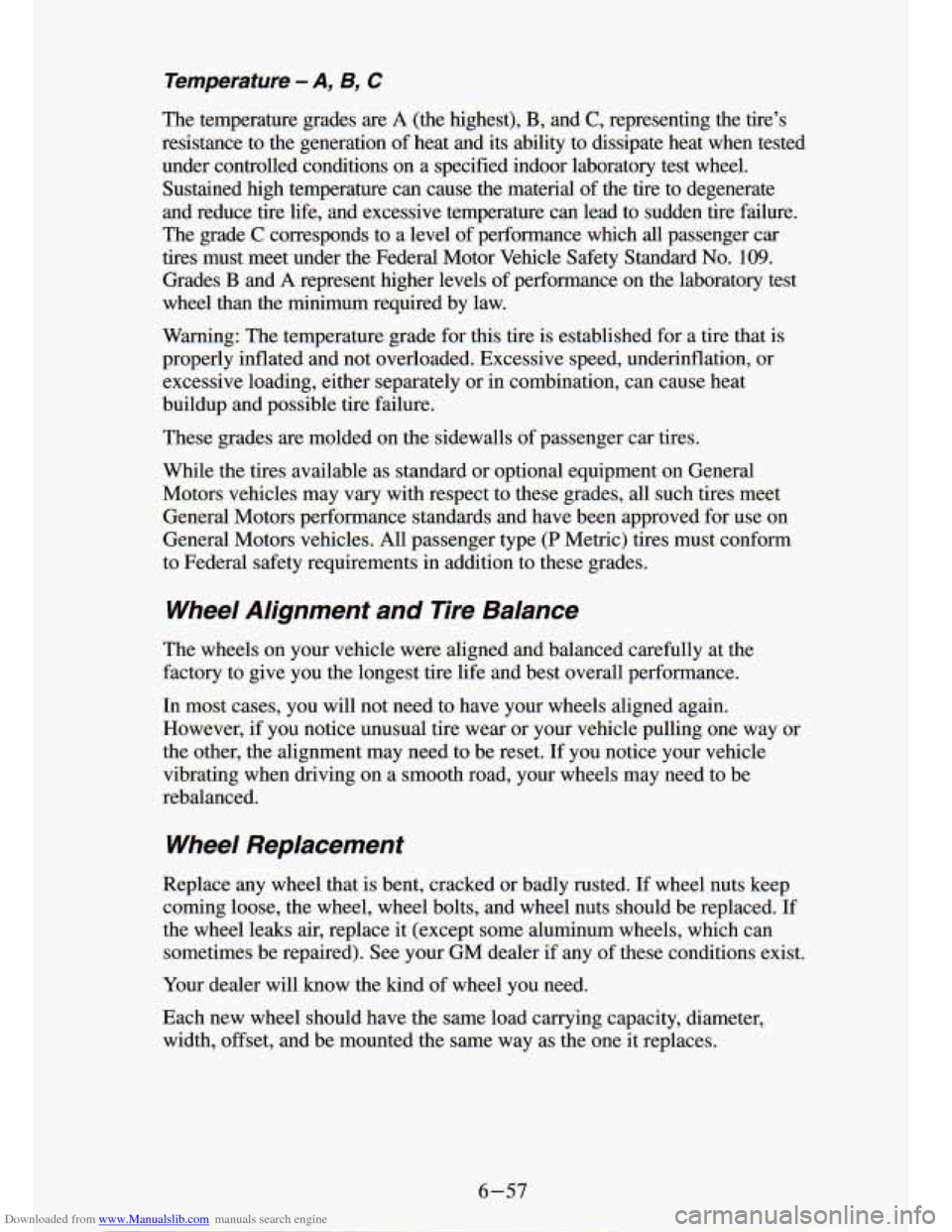
Downloaded from www.Manualslib.com manuals search engine Temperature -A, By C
The temperature grades are A (the highest), B, and C, representing the tire’s
resistance to the generation of heat and its ability
to dissipate heat when tested
under controlled conditions on a specified indoor laboratory tes\
t wheel.
Sustained high temperature can cause the material of the tire to degenerate
and reduce tire life, and excessive temperature can lead to su\
dden tire failure.
The grade
C corresponds to a level of performance which all passenger car
tires must meet under the Federal Motor Vehicle Safety Standard\
No. 109.
Grades B and A represent higher levels of performance on the laboratory test
wheel than the minimum required by law.
Warning: The temperature grade for
this tire is established for a tire that is
properly inflated and not overloaded. Excessive speed, underinfla\
tion, or
excessive loading, either separately or in combination, can cause heat
buildup and possible tire failure.
These grades are molded on
the sidewalls of passenger car tires.
While the tires available as standard or optional equipment on General
Motors vehicles may vary with respect to these grades, all such tires meet
General Motors performance standards and have been approved for use on
General Motors vehicles. All passenger type
(P Metric) tires must conform
to Federal safety requirements in addition to these grades.
Wheel Alignment and Tire Balance
The wheels on your vehicle were aligned and balanced carefully at the
factory to give you the longest tire life and best overall performance.
In most cases, you will not need to have your wheels aligned again.
However,
if you notice unusual tire wear or your vehicle pulling one way \
or
the other, the alignment may need to be reset. If you notice your vehicle
vibrating when driving
on a smooth road, your wheels may need to be
rebalanced.
Wheel Replacement
Replace any wheel that is bent, cracked or badly rusted. If wheel nuts keep
coming loose, the wheel, wheel bolts, and wheel nuts should be replaced.
If
the wheel leaks air, replace it (except some aluminum wheels, \
which can
sometimes be repaired). See your GM dealer if any of these conditions exist.
Your dealer will know the kind of wheel you need,
Each new wheel should have the same load carrying capacity, diameter,
width, offset, and be mounted the same way as the one it replaces.
6-57
Page 291 of 340
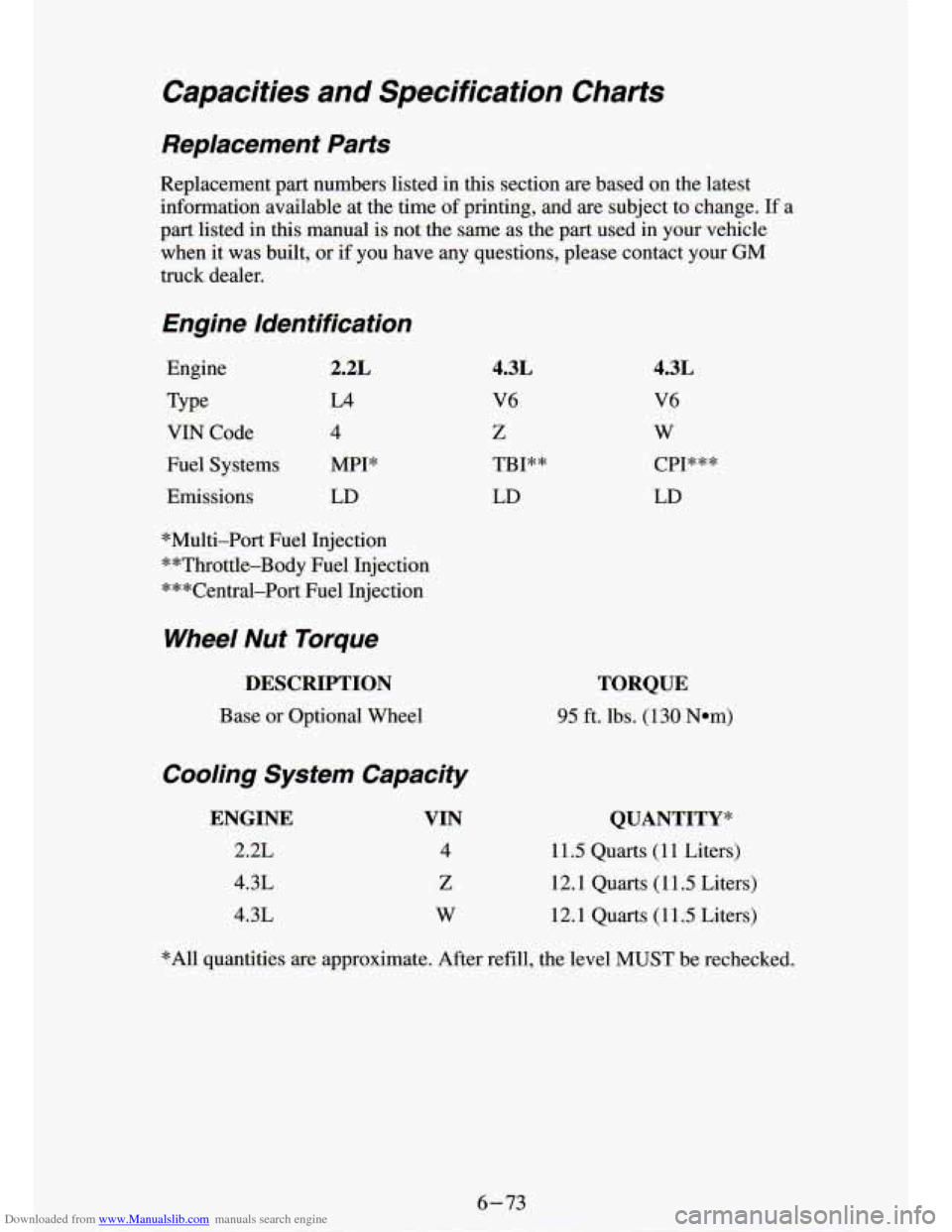
Downloaded from www.Manualslib.com manuals search engine Capacities and Specification Charts
Replacement Parts
Replacement part numbers listed in this section are based on the latest
information available at the time of printing,
and are subject to change. If a
part listed
in this manual is not the same as the part used in your vehicle
when it
was built, or if you have any questions, please contact your GM
truck dealer.
Engine Identification
Engine
Type
VZN Code
Fuel Systems
Emissions
2.2L
L4
4
MPI* LD
*Multi-Port Fuel Injection
**Throttle-Body Fuel Injection
***Central-Port Fuel Injection
Wheel Nut Torque
DESCRIPTION
Base or Optional Wheel
Cooling System Capacity
ENGINE VIN
2.2L 4 4.3L
Z
4.3L w
4.3L
V6
Z
TBI**
LD
4.3L
V6
W
CPI* * *
LD
TORQUE
35 ft. lbs. (130 Nom)
QUANTITY*
11.5 Quarts (1 1 Liters)
12.1 Quarts (11.5 Liters)
12.1 Quarts (11.5 Liters)
*All quantities are approximate. After refill, the level
MUST be rechecked.
6-73